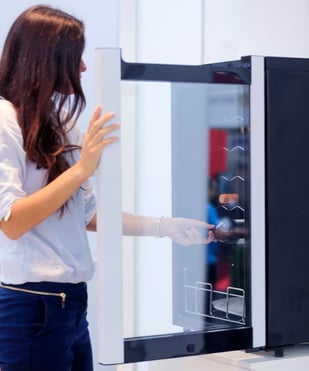
When it comes to high-end kitchen appliance design, great performance is as important on the outside as it is on the inside.
Serious designers of both commercial and residential appliances for the modern kitchen want features that feel luxurious. Many of today’s top-end appliances include counterbalancing, soft-close motion control, and other features for the ultimate in safety and convenience.
A well-made appliance door hinge separates your design from the crowd by combining all of these qualities into one dependable mechanism.
What Sets a Modern Appliance Door Hinge Apart from the Rest?
The standard appliance door hinge has been around for a long time. It does its job by keeping appliance doors level and allowing them to swing out and in. Yawn.
Modern technology has significantly improved this design with motion control and soft-open and soft-close solutions. Motion control is made possible by using spring-loaded hinge solutions and counterbalancing.
Use motion control hinges to prevent excessive swinging of (often scalding-hot) doors and keep (often heavy) lids from slamming and injuring the user. They can also lighten the load the user has to lift, push or pull – even the heaviest lids and doors can require 5 lbs. or less of force to lift. We love that feature for flip-up kitchen countertops!
Benefits of motion control hinges include:
- Easier lid lifting: Counterbalancing can make heavy lids easy to lift and move.
- Damping: As an opening or closing door or lid increases in speed, an added mechanism can increase the resistance so that it closes softly and smoothly.
- Positioning: You can use spring-loaded hinges to customize door and lid positioning.
Options for positioning include:
- Detent: An operator can feel when the door or lid reaches the desired angle or multiple angles.
- Free stop: Reposition doors or lids in small increments along their range of motion.
- Lock: Keeps a door or lid in place with sufficient force.
Want to learn how motion control and counterbalance can improve your product?Download our free resource: |
How Are Motion Control Hinges Used in Modern Kitchen Appliance Design?
Motion control has been the source of soft-closing mechanisms for cabinet doors and drawers for many years now. Now, what about the rest of the kitchen?
Here’s a hinge design guide of where you can easily integrate motion control hinges into the kitchen:
- Wine coolers
- Dishwashers
- Refrigerators
- Ovens
- Soft close cabinets and drawers
- Bars and countertops
- TV monitor lifts
Wine Coolers
A soft-close feature on wine storage fridges makes it easier to avoid disturbing valuable bottles of wine. Instead of a potentially disruptive slamming door, a soft close hinge mechanism ensures a gentle seal every time.
Dishwashers
There are higher-end dishwasher hinges available now that feature motion-control hinge designs. Among their features are soft-close motion control to avoid slamming and rattling glassware, both when the door is propped open and when the door is closed.
Refrigerator Hinges:
Refrigerators keep rising in price as they add features, yet it hasn’t stopped people from buying them.
While not as exciting as integrated Wi-Fi, soft-close refrigerator hinges ensure that the fridge door never slams shut. Use motion control to dictate exactly where the door will open and how quickly it will get there.
Ovens
French door ovens and side-swing wall ovens use motion control to protect both the appliance and the user. You can also improve your pull-out oven design by adding the following:
- Soft-close hinge mechanisms
- Soft-open hinge mechanisms
- A mid-motion stop
As you know, all oven hinges must withstand high temperatures. Mechanical spring hinges are the best design choice because they don’t rupture in high heat like gas cylinders.
Your hinge manufacturer should be able to help you design an oven door system that opens predictably and safely.
Soft-Close Cabinets and Drawers
Soft-close cabinets and drawers are a popular choice for modern kitchens. Designed with special hinges that make them close softly and gently, both are prevented from slamming shut. Through motion control, the soft close cabinet hinges slow down the closing of the door or drawer, making it easy to close without making noise or causing damage to the door or frame.
Bars & Countertops
Large, heavy bars and countertops can be hinged to allow access in and out of a kitchen area. While common in bars and restaurants, many lack the right kitchen countertop hinge to ensure safety and longevity.
Rather than making a waiter resort to DIY-ing a way to keep the flap up during a busy night, install a flip-up countertop hinge that will easily open and close. This way, staff won’t have to lift a 75-lb. granite countertop 50 times a night, and there’s no risk of their makeshift solution failing.
TV Monitor Lifts
Excessive? Maybe. But hey, why not?
Those familiar with ergonomic office design may be aware of monitor lifts and TV lifts. These products, also gaining popularity in high-end hotels, let consumers watch TV while cooking or eating. After watching, users can slide the TV back down into the counter and get that space back for cooking or holding dishes.
How Can a Hidden Appliance Door Hinge Refine Kitchen Design?
Taking things a step further, advances in motion control technology can upgrade how many appliances complement a kitchen’s aesthetic.
Take a refrigerator for instance. With a hidden hinge, the appliance is able to blend in seamlessly with cabinetry around it or when recessed into a wall. Expertly designed and strategically installed out of sight, a hidden hinge still provides the same level of functionality and performance as other heavy-duty or custom hinges.
And concealed hinges aren’t just for refrigerators – they can be integrated into many staples of the kitchen, including:
- Ovens
- Cabinets
- Dishwashers
- Wine coolers
- Beverage bins
FAQ: Appliance Door Hinge DesignEven experienced designers have questions when it comes to appliance door hinge performance and development. Here are a few of the most common ones. Q: How early should hinge design be considered in the appliance development process?A: Appliance door hinge design should be part of the process from the start. Early planning allows engineers and designers to align hinge performance with motion, load, and safety goals before the layout is finalized. This prevents last-minute changes that could affect balance or usability. When hinge design is integrated early, it’s easier to maintain both function and appearance. Features like soft-close motion or hidden hinges can then be built into the appliance’s structure instead of adapted later, resulting in smoother performance and a cleaner design. Q: Can motion control or hidden hinges be customized for unique appliance designs?A: Yes. Customization is a standard part of modern appliance door hinge design. Engineers can define torque, damping, and counterbalance force to match how a product moves and feels. This helps achieve smoother motion and consistent performance across repeated use. Design tools such as the Vectis DYO App make that process faster and more accurate. By entering load, geometry, and range-of-motion data, designers can model how a hinge will behave before a prototype is built. It’s a practical way to confirm fit and function early in the design phase. |
How Does Appliance Door Hinge Design Balance Form and Function?
The best high-end kitchen designs are a combination of form and function.
The appeal of motion control is that it can do both. The smooth feeling it lends to a door or lid gives off a luxurious vibe. And its ability to move heavy loads in any way you want makes your kitchen safer and more convenient.
Have a Motion Control Challenge?
Our engineers can help you solve it – reach out for design insight or hinge guidance that fits your exact application.
Editor's Note: This article was originally posted in January 2020 and was recently updated to reflect changes in insight and resources.
.png?width=12000&height=2033&name=WeberKnappLogo_white%20(1).png)




